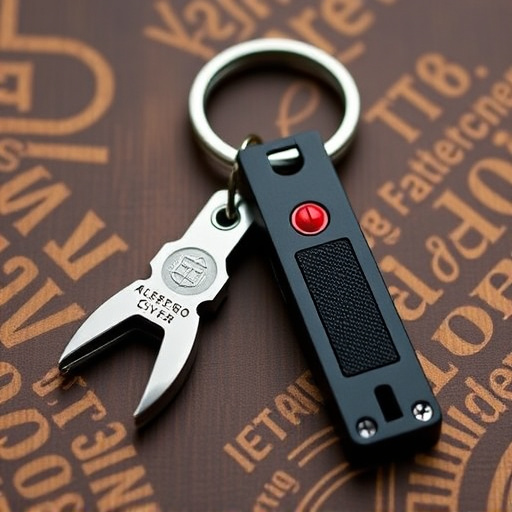Before carrying a keychain defense device, check your region's laws on the Prohibited Keychain Weapons List to ensure legal compliance and effective personal protection while adhering to local regulations.
“Enhance your personal safety while walking with a keyring personal protection tool. In today’s diverse legal landscape, understanding what constitutes a permissible keychain weapon is crucial. This guide navigates the do’s and don’ts of carrying hidden self-defense tools, offering insights on essential features to consider. From legal restrictions on prohibited keychain weapons lists to expert tips for smart carry and use, discover how to choose the right self-defense tool for your peace of mind. Stay informed and empowered.”
- Understanding Legal Limits: What's Allowed on Your Keychain
- Essential Self-Defense Tools: Small Yet Powerful Options
- The Do's and Don'ts of Carrying Hidden Weapons Legally
- Choosing the Right Weapon: Size, Shape, and Effectiveness
- Staying Safe While Walking: Tips for Smart Carry and Use
Understanding Legal Limits: What's Allowed on Your Keychain
When considering a keyring personal protection tool for walking, it’s crucial to understand the legal limits on what you can carry on your keychain. Different regions have varying laws regarding prohibited keychain weapons. Always check local and state regulations before equipping yourself with any self-defense device.
The Prohibited Keychain Weapons List typically includes items like knives with blades longer than a certain length, metal batons, tasers, and other electronic stun devices. Some jurisdictions also prohibit items that could cause serious harm or be used as weapons, even if they’re not traditionally considered “weapons.” Staying within legal boundaries ensures you’re following the law and can effectively protect yourself while avoiding unnecessary legal issues.
Essential Self-Defense Tools: Small Yet Powerful Options
In today’s digital era, personal safety while walking alone is a growing concern. While self-defense options range from pepper spray to personal alarms, one often overlooked yet powerful tool is the keychain defense device. These small yet formidable tools can be easily carried on a keyring, making them convenient and accessible for unexpected situations.
Keychain weapons designed for self-defense often come in various forms, including tactical flashlights with stun features or compact pepper spray canisters. Some models even incorporate sharp blades or impact tools that can deter attackers. Despite their compact size, these devices pack a punch, providing users with an extra layer of security while adhering to local laws regarding prohibited keychain weapons listed as legal self-defense tools.
The Do's and Don'ts of Carrying Hidden Weapons Legally
When considering a keychain personal protection tool, it’s crucial to understand the legalities surrounding hidden weapons. In many jurisdictions, specific items are prohibited from being carried on your person or in your possession without a license. The Prohibited Keychain Weapons List varies by region but typically includes items like stun guns, tasers, and certain types of knives. Always check local laws to avoid legal consequences.
Do’s include familiarizing yourself with the legal definition of self-defense in your area, obtaining any necessary permits or licenses, and ensuring your chosen tool is legal for open carry (if permitted) or easily concealed. Don’ts involve carrying prohibited items, ignoring training requirements, or using your protection tool without understanding its limitations and potential consequences. Remember, legality is paramount; use these tools responsibly and within the bounds of the law.
Choosing the Right Weapon: Size, Shape, and Effectiveness
When selecting a keychain personal protection tool, understanding what makes a weapon effective and suitable for your needs is paramount. Size plays a significant role; smaller keychains may offer ease of carry, but larger ones can provide better reach and impact. Consider the shape too—a sharp edge or pointed tip offers different advantages depending on your situation.
Moreover, effectiveness should guide your choice. While some keychains focus on cutting or piercing, others emphasize striking. Understanding what you’re most likely to encounter during a potential threat—whether it’s a physical assault or a need to break glass—will help you narrow down the best option. It’s also crucial to stay clear of prohibited keychain weapons listed in local laws to avoid legal complications.
Staying Safe While Walking: Tips for Smart Carry and Use
Staying safe while walking is a paramount concern, especially in unfamiliar or potentially risky environments. One innovative solution gaining traction as a personal protection tool for pedestrians is the keychain self-defense device. These compact tools, often featuring tools like pepper spray or emergency alarm functions, offer a subtle yet effective deterrent against potential threats.
When carrying a keychain defense tool, it’s crucial to familiarize yourself with local laws regarding prohibited keychain weapons. Understanding what constitutes an allowable personal protection device can help avoid legal issues. Always store the tool securely on your keychain and keep it readily accessible for quick deployment if needed. Practice discretely activating the alarm or spray to ensure its effectiveness without drawing unnecessary attention during your walk.
When equipped with the right personal protection tool, like those suitable for a keychain, you can enhance your safety while walking. However, it’s crucial to understand legal limits and adhere to guidelines on carrying hidden weapons to avoid any prohibited keychain weapons listed by law. By combining knowledge of self-defense tools, smart carry techniques, and legal considerations, you can confidently protect yourself while staying within the boundaries of the law.
